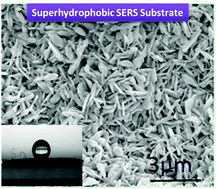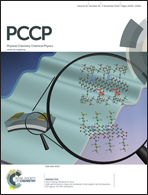Superhydrophobic Ag nanostructures on polyaniline membranes with strong SERS enhancement
Abstract
We demonstrate here a facile fabrication of n-dodecyl mercaptan-modified superhydrophobic Ag nanostructures on polyaniline membranes for molecular detection based on SERS technique, which combines the superhydrophobic condensation effect and the high enhancement factor. It is calculated that the as-fabricated superhydrophobic substrate can exhibit a 21-fold stronger molecular condensation, and thus further amplifies the SERS signal to achieve more sensitive detection. The detection limit of the target molecule, methylene blue (MB), on this superhydrophobic substrate can be 1 order of magnitude higher than that on the hydrophilic substrate. With high reproducibility, the feasibility of using this SERS-active superhydrophobic substrate for quantitative molecular detection is explored. A partial least squares (PLS) model was established for the quantification of MB by SERS, with correlation coefficient R2 = 95.1% and root-mean-squared error of prediction (RMSEP) = 0.226. We believe this superhydrophobic SERS substrate can be widely used in trace analysis due to its facile fabrication, high signal reproducibility and promising SERS performance.


 Please wait while we load your content...
Please wait while we load your content...